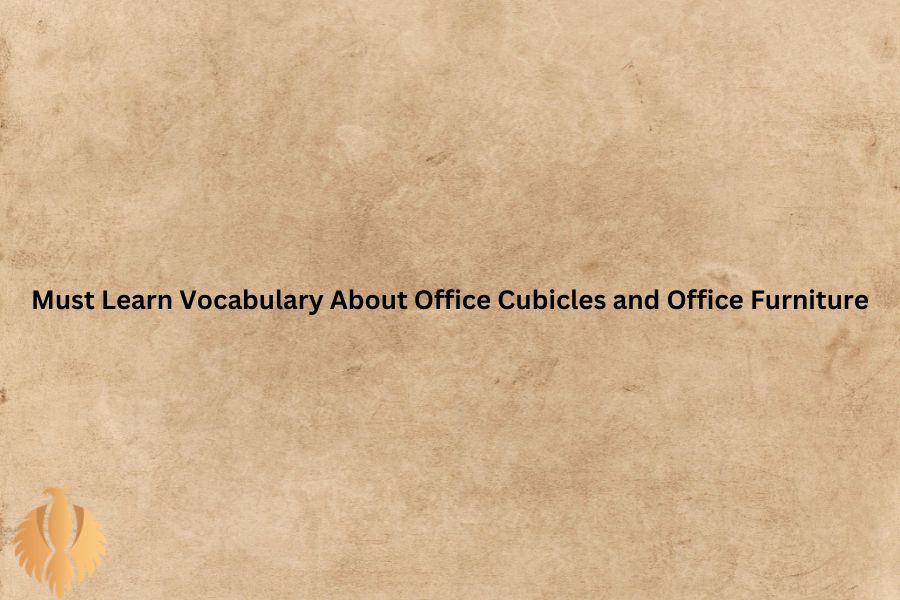Whether you’re setting up a new office, optimizing an existing one, or just looking to understand more about the workspace environment, having a solid grasp of the relevant vocabulary is essential.
This comprehensive guide will cover must-learn terms and concepts that will help you navigate the world of office design and furniture with confidence.
By the end of this article, you’ll have a better understanding of the key terms and be well-equipped to create a productive and aesthetically pleasing workspace.
So, let’s get started and explore the must-learn vocabulary related to office cubicles and office furniture.
You might also enjoy: Boys’ or Boy’s– Which One is Correct? + Example
Understanding Office Cubicles
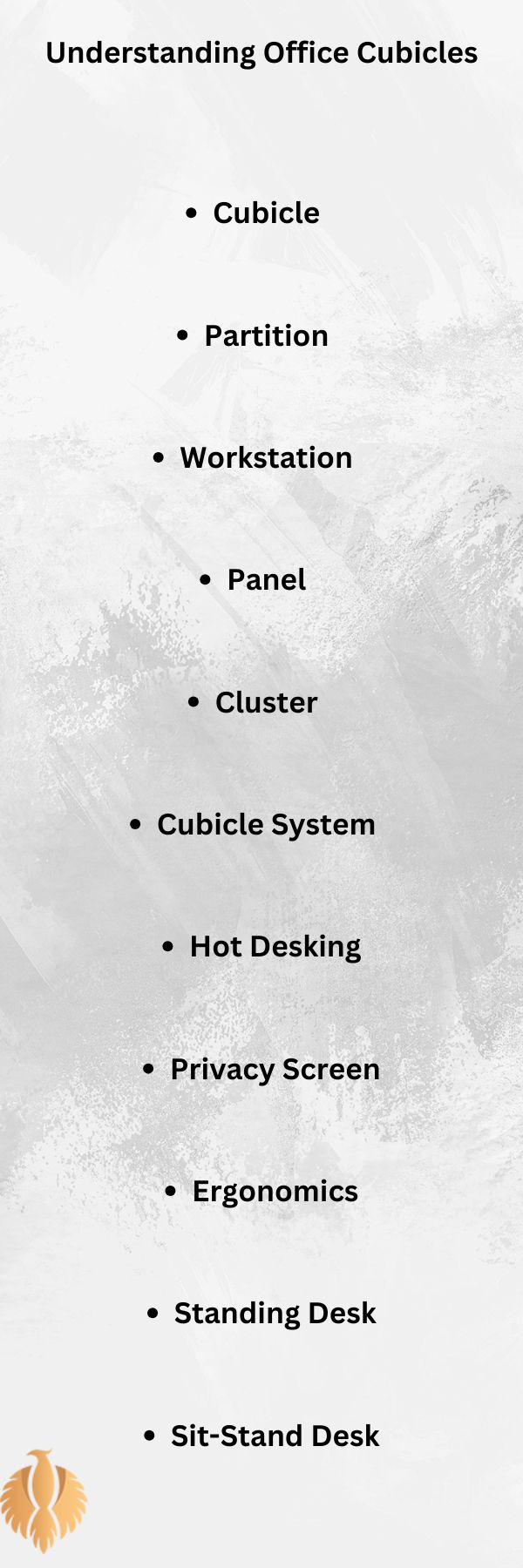
Office cubicles are a staple of many workplaces, offering a balance between open-plan offices and private rooms. Here are some key terms related to office cubicles:
- Cubicle: A partially enclosed workspace separated by partitions, providing privacy to office workers. Cubicles are designed to maximize space efficiency and offer a degree of personal space.
- Partition: A divider used in office spaces to create individual work areas within a larger open space. Partitions can be made of various materials, including fabric, glass, metal, and wood.
- Workstation: The area where an employee performs their job duties, typically consisting of a desk, chair, computer, and other necessary equipment.
- Panel: A flat, often rectangular, component that forms part of a cubicle. Panels can be connected to create walls or dividers within the office space.
- Cluster: A group of cubicles arranged together in a specific layout to promote collaboration or fit within a particular space.
- Cubicle System: A modular system of panels and components used to create customized workspaces. These systems are often adjustable and can be reconfigured to suit changing needs.
- Hot Desking: A workspace setup where employees do not have assigned desks but instead use available workstations on a first-come, first-served basis.
- Privacy Screen: A panel or barrier added to cubicles to increase privacy and reduce distractions. Privacy screens can be opaque or semi-transparent.
- Ergonomics: The study of designing equipment and workspaces to fit the user’s needs, enhancing comfort, efficiency, and safety. The purpose of ergonomic workplace furniture is to lessen stress and accidents.
- Standing Desk: A desk that allows the user to stand while working. Standing desks can be adjustable or fixed and are often used to promote better posture and health.
- Sit-Stand Desk: A desk that can be adjusted between sitting and standing heights, allowing users to alternate between positions throughout the day.
- Cubicle Door: A door that can be added to a cubicle to enhance privacy and reduce noise. Cubicle doors can be sliding or hinged.
- Acoustic Panels: Panels designed to absorb sound, reducing noise levels in the office and creating a more conducive work environment.
- Cubicle Shelves: Shelving units that can be added to cubicles to provide extra storage space for office supplies and personal items.
- Task Lighting: Adjustable lighting specifically designed to illuminate the work area, reducing eye strain and improving focus.
You Might Also Enjoy: Top 60 Most Common Simple Sentences In English
Office Furniture Essentials
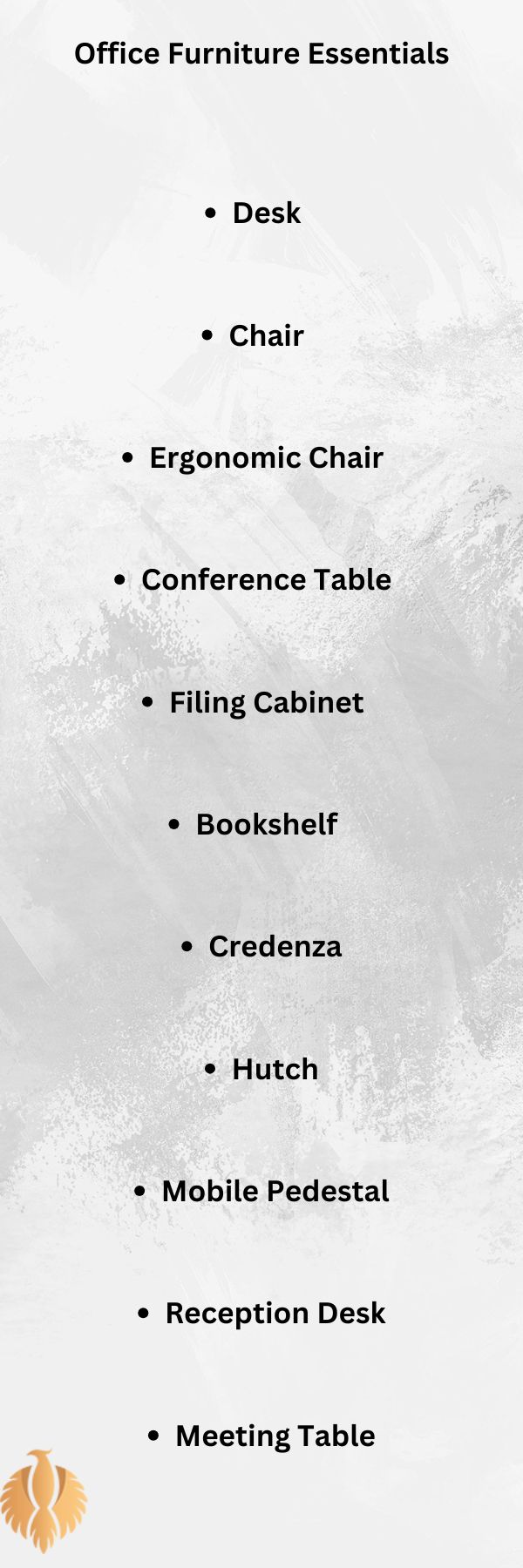
For a workspace to be both comfortable and effective, office furniture is essential. These are some essential terms for office furniture:
- Desk: A piece of furniture with a flat surface used for writing, working on a computer, or other office tasks. Desks can be rectangular, L-shaped, or U-shaped, among other sizes and shapes.
- Chair: Seating designed to support the user while working. Office chairs often feature adjustable height, armrests, lumbar support, and swivel capabilities.
- Ergonomic Chair: A chair designed to provide maximum support and comfort, reducing the risk of strain and injury. Armrests, lumbar support, and seat height adjustment are possible features.
- Conference Table: A large table used for meetings and collaborative work. Conference tables can accommodate multiple people and often include features like cable management and power outlets.
- Filing Cabinet: A storage unit with drawers used for organizing and storing documents. Filing cabinets can be vertical or lateral and are often lockable for security.
- Bookshelf: A piece of furniture with horizontal shelves used for storing books, binders, and decorative items.
- Credenza: A low, horizontal storage unit often used in offices for additional storage and workspace. Credenzas can include drawers, shelves, and cabinets.
- Hutch: An additional storage unit placed on top of a desk or credenza, providing extra storage space for office supplies and personal items.
- Mobile Pedestal: A small, portable storage unit with drawers that can be moved around the office. Mobile pedestals are often placed under desks for easy access to personal items and documents.
- Reception Desk: The front desk in an office, typically located in the reception area. Reception desks are designed to provide a welcoming and functional space for visitors and employees.
- Meeting Table: A smaller table used for informal meetings and collaborative work. Meeting tables can be round, rectangular, or square.
- Work Table: A versatile table used for various office tasks, including collaborative work, projects, and temporary workstations.
- Task Chair: A chair specifically designed for tasks that require extended periods of sitting. Task chairs often feature adjustable height, lumbar support, and swivel capabilities.
- Visitor Chair: Seating provided for visitors in an office. Visitor chairs are typically placed in reception areas, meeting rooms, and offices.
- Breakroom Furniture: Furniture designed for employee break areas, including tables, chairs, sofas, and storage units.
- Cafeteria Table: A table used in office cafeterias and breakrooms for dining and socializing. Cafeteria tables can be rectangular, round, or square.
- Standing Desk Converter: An accessory that can be placed on top of an existing desk to convert it into a standing desk. Standing desk converters are adjustable and portable.
- Keyboard Tray: An accessory attached to a desk that holds the keyboard, allowing for ergonomic positioning. Keyboard trays can be adjustable for height and angle.
- Monitor Arm: An adjustable arm that holds a computer monitor, allowing for flexible positioning and improved ergonomics.
- Desk Mat: A protective surface placed on top of a desk to protect it from scratches and spills. Desk mats can also provide a smooth surface for writing and using a mouse.
You might also enjoy: Top 100 Commonly Used Verbs That Start With A [2024]
Modern Office Trends and Innovations
The office furniture industry is always changing, with new developments and trends influencing how we operate. Here are some key terms related to modern office trends:
- Collaborative Workspaces: Office spaces designed to promote collaboration and teamwork. Collaborative workspaces often include open-plan areas, shared desks, and meeting pods.
- Flexible Workspaces: Office environments that can be easily reconfigured to accommodate different work styles and tasks. Flexible workspaces often include modular furniture and movable partitions.
- Biophilic Design: A design approach that incorporates natural elements, such as plants and natural light, into the office environment. Biophilic design aims to improve employee well-being and productivity.
- Sustainable Furniture: Office furniture made from environmentally friendly materials and production methods. Sustainable furniture is designed to reduce environmental impact and promote sustainability.
- Activity-Based Working (ABW): A workspace design philosophy that provides employees with a variety of work settings to choose from based on the task at hand. ABW environments often include quiet zones, collaborative areas, and breakout spaces.
- Smart Furniture: Office furniture integrated with technology to enhance functionality and convenience. Smart furniture can include features like built-in charging ports, wireless charging pads, and adjustable settings controlled via smartphone apps.
- Agile Workspace: An office design that supports flexibility, mobility, and adaptability. Agile workspaces often include movable furniture, open-plan areas, and a variety of work settings to accommodate different work styles.
- Ergonomic Accessories: Products designed to enhance ergonomics and comfort in the workplace. Ergonomic accessories can include wrist rests, footrests, monitor risers, and ergonomic mice.
- Touchdown Spaces: Small, temporary workspaces designed for short-term use, often used by employees who are on the move or visiting the office. Touchdown spaces can include high-top tables, phone booths, and quiet pods.
- Acoustic Solutions: Products and designs aimed at reducing noise levels and improving acoustics in the office. Acoustic solutions can include soundproofing panels, acoustic ceiling tiles, and noise-canceling furniture.
- Wellness Room: A designated space in the office for relaxation, meditation, or taking a break. Wellness rooms can include comfortable seating, soft lighting, and calming decor.
- Height-Adjustable Furniture: Furniture that can be adjusted to different heights to accommodate various tasks and user preferences. Height-adjustable furniture can include desks, chairs, and tables.
- Modular Furniture: Furniture designed with interchangeable and adjustable components, allowing for customization and reconfiguration. Modular furniture is ideal for flexible and dynamic work environments.
- Privacy Pods: Enclosed or semi-enclosed workspaces designed to provide privacy and reduce distractions. Privacy pods can be used for focused work, phone calls, or small meetings.
- Dynamic Office Design: An approach to office design that emphasizes flexibility, adaptability, and movement. Dynamic office design often includes movable furniture, adjustable workstations, and a variety of work settings.
You might also enjoy: Top 30 Gambling Phrases and Idioms In 2024
Office Furniture Materials and Finishes
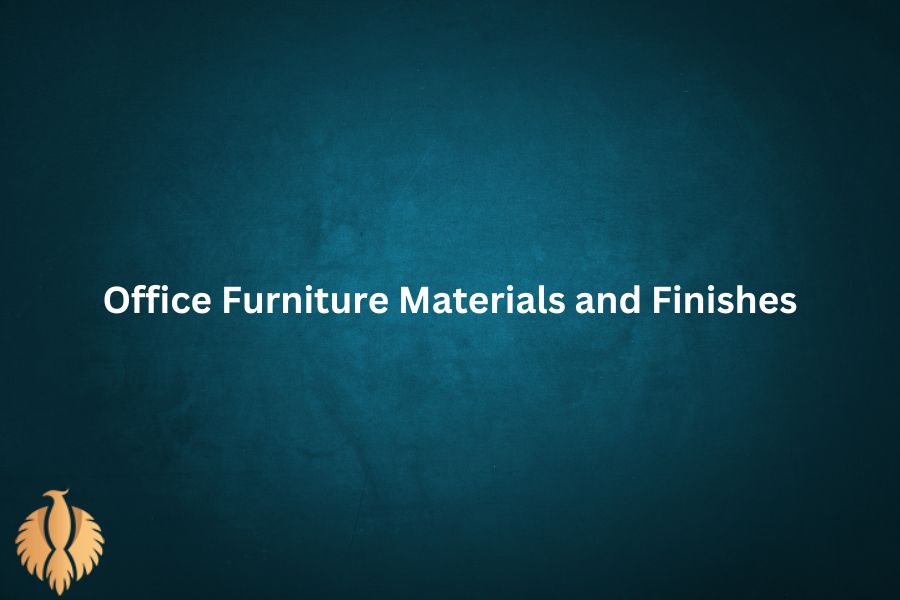
The materials and finishes used in office furniture can significantly impact the aesthetics and functionality of the workspace. Here are some key terms related to office furniture materials and finishes:
- Laminate: A synthetic material used to cover the surface of furniture, providing durability and a wide range of design options. Laminate is often used for desks, tables, and cabinets.
- Veneer: A thin layer of real wood applied to the surface of furniture to give the appearance of solid wood while being more cost-effective and lightweight. Veneer is commonly used in executive desks and high-end office furniture.
- Solid Wood: Furniture made entirely from natural wood, known for its durability and timeless aesthetic. Solid wood is often used in high-quality office furniture, such as executive desks and conference tables.
- Metal: A strong and durable material used in office furniture for frames, legs, and supports. Metal can be finished in various ways, including powder coating, chrome plating, and anodizing.
- Glass: A sleek and modern material used for tabletops, partitions, and doors. Glass can be clear, frosted, or tinted to provide different levels of privacy and aesthetic appeal.
- Fabric: A textile material used for upholstery in office chairs, sofas, and partitions. Fabric can come in various colors, patterns, and textures, providing comfort and style.
- Leather: A luxurious and durable material used for high-end office chairs and executive furniture. Leather provides a sophisticated look and is known for its longevity.
- Mesh: A breathable fabric often used in office chairs, providing ventilation and comfort. Mesh chairs are popular for their ergonomic benefits.
- Acrylic: A lightweight and transparent material used for partitions, desk accessories, and decorative elements. Acrylic is shatter-resistant and can add a modern touch to the office.
- Melamine: A type of laminate made from resin-coated paper. Melamine is durable, scratch-resistant, and commonly used for office desks and storage units.
- Powder Coating: A finishing process where a dry powder is applied to metal surfaces and then cured under heat. A variety of colors are available for the long-lasting and visually appealing finish that powder coating offers.
- Chrome: A shiny and reflective metal finish often used for office chair bases, legs, and accents. Chrome provides a sleek and modern look.
- Anodizing: An electrochemical process that converts the metal surface into a durable, corrosion-resistant finish. Anodized aluminum is commonly used in office furniture for frames and supports.
- Frosted Glass: Glass that has been treated to have a frosted or opaque appearance, providing privacy while allowing light to pass through. Frosted glass is used in partitions, doors, and tabletops.
- Tempered Glass: Glass that has been heat-treated for increased strength and safety. Tempered glass is used in office furniture for its durability and resistance to shattering.
You might also enjoy: Which of the Following: Definition + Complete Usage + Grammar
Office Layout and Design Terms
Understanding office layout and design concepts is crucial for creating an efficient and aesthetically pleasing workspace. Here are some key terms related to office layout and design:
- Open Plan Office: An office layout where workspaces are not enclosed by walls or partitions, promoting collaboration and communication among employees.
- Private Office: An enclosed office space designed for individual use, providing privacy and quiet for focused work.
- Coworking Space: A shared office environment where individuals from different companies or freelancers work together in a communal space. Coworking spaces often include shared amenities and flexible workstations.
- Desk Sharing: A workspace arrangement where multiple employees share the same desk or workstation at different times. Desk sharing is common in flexible and remote work environments.
- Breakout Space: An informal area within the office where employees can relax, socialize, or have informal meetings. Tables, entertainment options, and cozy seating are common features of breakout rooms.
- Reception Area: The front area of an office where visitors are greeted and received. The reception area typically includes a reception desk, seating for visitors, and decorative elements.
- Collaboration Zone: A designated area within the office designed to facilitate teamwork and collaboration. Collaboration zones often include whiteboards, flexible seating, and tech-enabled tools.
- Quiet Zone: A designated area within the office where noise levels are kept to a minimum, allowing employees to focus on tasks that require concentration. Quiet zones often include private workstations and soundproofing elements.
- Activity-Based Workspace (ABW): A workspace design that provides employees with various types of work settings to choose from based on the task at hand. ABW environments often include open-plan areas, private offices, and collaborative zones.
- Zoning: The practice of dividing the office space into different areas based on function and activity. Zoning helps create a more organized and efficient workspace.
- Wayfinding: The use of signage, graphics, and design elements to help employees and visitors navigate the office space. Wayfinding can include directional signs, maps, and color-coded zones.
- Space Planning: The process of organizing and arranging office furniture and workspaces to optimize space and workflow. Space planning considers factors such as employee needs, traffic flow, and ergonomic principles.
- Hoteling: A workspace arrangement where employees reserve desks or workstations in advance, similar to booking a hotel room. Hoteling is common in flexible and remote work environments.
- Break Room: An area within the office where employees can take breaks, eat, and socialize. Break rooms often include kitchen facilities, seating, and entertainment options.
- Huddle Room: A small, informal meeting room designed for quick, impromptu meetings. Huddle rooms often include a table, chairs, and collaboration tools.
Office Furniture Maintenance and Care
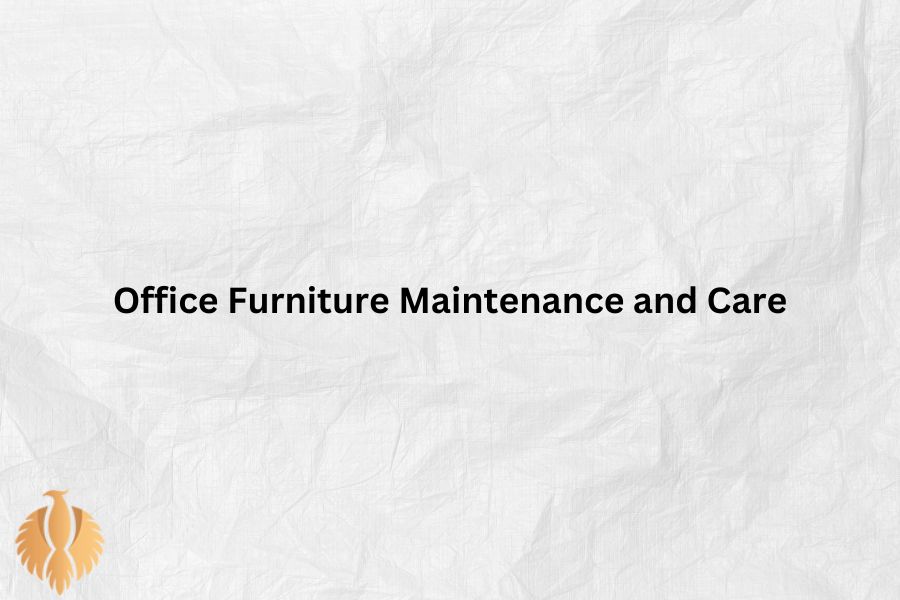
Proper maintenance and care of office furniture are essential for prolonging its lifespan and keeping the workspace looking professional. Here are some key terms related to office furniture maintenance and care:
- Cleaning: The process of removing dirt, dust, and stains from office furniture. Cleaning methods vary based on the material, such as wiping down surfaces with a damp cloth, vacuuming upholstery, or using specialized cleaning products.
- Polishing: The process of applying a polish or wax to wood or metal surfaces to restore shine and protect the finish. Polishing helps maintain the appearance of desks, tables, and cabinets.
- Repairs: Fixing any damage or wear and tear on office furniture. Repairs can include tightening screws, replacing broken parts, or reupholstering chairs.
- Reupholstering: The process of replacing the fabric or leather on office chairs, sofas, and other upholstered furniture. Reupholstering can refresh the appearance of the furniture and extend its lifespan.
- Refinishing: The process of sanding down and applying a new finish to wood furniture. Refinishing can restore the appearance of desks, tables, and cabinets.
- Preventative Maintenance: Regular maintenance tasks are performed to prevent damage and prolong the life of office furniture. Preventative maintenance can include lubricating moving parts, tightening screws, and inspecting for wear and tear.
- Warranty: A guarantee provided by the manufacturer that covers repairs or replacements for a specified period. Understanding the warranty terms for office furniture can help ensure proper maintenance and care.
- Protective Covers: Covers used to protect office furniture from damage, such as chair covers, desk mats, and keyboard protectors. Protective covers can help prevent scratches, stains, and wear.
- Ergonomic Adjustments: Making adjustments to office furniture to ensure proper ergonomics, such as adjusting chair height, adding lumbar support, or repositioning monitors.
- Storage: Properly storing office furniture when not in use to prevent damage. Storage methods can include stacking chairs, using protective covers, and storing furniture in a dry, climate-controlled environment.
You might also enjoy: To Bad Or Too Bad – Correct Grammar + Examples [2024]
Conclusion
Understanding the vocabulary related to office cubicles and office furniture is essential for creating a functional, comfortable, and aesthetically pleasing workspace.
From cubicle components and ergonomic accessories to modern office trends and maintenance practices, this comprehensive guide covers the must-learn terms and concepts to navigate the world of office design and furniture confidently.
Whether you’re setting up a new office, optimizing an existing one, or simply looking to enhance your knowledge, this guide provides valuable insights and practical information to help you make informed decisions.
By mastering these terms, you’ll be well-equipped to create a productive and inspiring work environment that meets the needs of your team and organization.

Hi, welcome to my blog! My name is Omid and I am thrilled to have you here! I am an English language teacher with 12 years of experience and hold multiple international certifications (TESOL, IELTS, TOEFL, PTE, CELTA). Additionally, I hold a PhD in Applied Linguistics with a specialization in Teaching English as a Second Language (TESL), which fuels my passion for teaching English and assisting others in mastering the language. To me, nothing is more rewarding than helping individuals enhance their English language abilities through various methods. So, let’s embark on this journey of learning English together.

